最新大学英语作文模板电子教案
- 格式:doc
- 大小:57.50 KB
- 文档页数:35
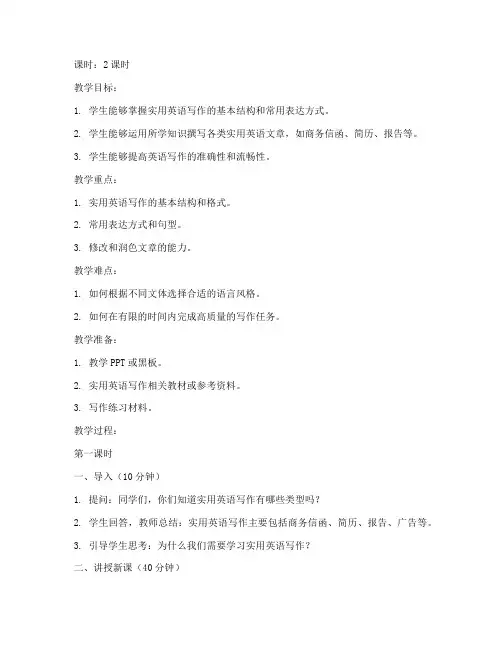
课时:2课时教学目标:1. 学生能够掌握实用英语写作的基本结构和常用表达方式。
2. 学生能够运用所学知识撰写各类实用英语文章,如商务信函、简历、报告等。
3. 学生能够提高英语写作的准确性和流畅性。
教学重点:1. 实用英语写作的基本结构和格式。
2. 常用表达方式和句型。
3. 修改和润色文章的能力。
教学难点:1. 如何根据不同文体选择合适的语言风格。
2. 如何在有限的时间内完成高质量的写作任务。
教学准备:1. 教学PPT或黑板。
2. 实用英语写作相关教材或参考资料。
3. 写作练习材料。
教学过程:第一课时一、导入(10分钟)1. 提问:同学们,你们知道实用英语写作有哪些类型吗?2. 学生回答,教师总结:实用英语写作主要包括商务信函、简历、报告、广告等。
3. 引导学生思考:为什么我们需要学习实用英语写作?二、讲授新课(40分钟)1. 实用英语写作的基本结构和格式- 以商务信函为例,讲解信头、信内地址、称呼、正文、结束语、签名等部分的格式和注意事项。
- 以简历为例,讲解简历的基本结构,如个人信息、教育背景、工作经历、技能特长等。
2. 常用表达方式和句型- 列举常用表达方式,如常用动词、形容词、副词等。
- 举例说明常用句型,如疑问句、祈使句、感叹句等。
3. 修改和润色文章的能力- 强调修改和润色的重要性。
- 介绍一些常见的修改方法,如检查语法错误、句子结构、逻辑关系等。
三、课堂练习(30分钟)1. 学生根据所学知识,尝试撰写一篇商务信函或简历。
2. 教师巡视指导,帮助学生解决写作过程中遇到的问题。
第二课时一、复习巩固(10分钟)1. 学生分享自己的写作成果,教师点评并提出改进意见。
2. 复习上一节课所学内容,巩固实用英语写作的基本结构和常用表达方式。
二、拓展训练(40分钟)1. 教师提供一篇未完成的实用英语文章,要求学生根据文章类型和内容,补充完整。
2. 学生分组讨论,共同完成写作任务。
三、总结与作业(10分钟)1. 教师总结本节课的重点内容。
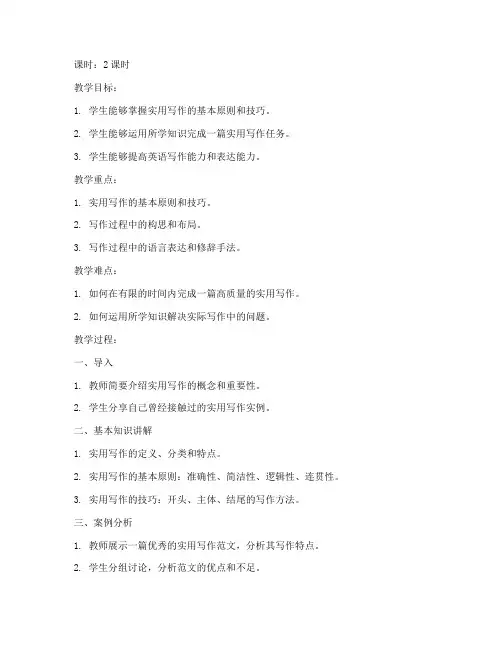
课时:2课时教学目标:1. 学生能够掌握实用写作的基本原则和技巧。
2. 学生能够运用所学知识完成一篇实用写作任务。
3. 学生能够提高英语写作能力和表达能力。
教学重点:1. 实用写作的基本原则和技巧。
2. 写作过程中的构思和布局。
3. 写作过程中的语言表达和修辞手法。
教学难点:1. 如何在有限的时间内完成一篇高质量的实用写作。
2. 如何运用所学知识解决实际写作中的问题。
教学过程:一、导入1. 教师简要介绍实用写作的概念和重要性。
2. 学生分享自己曾经接触过的实用写作实例。
二、基本知识讲解1. 实用写作的定义、分类和特点。
2. 实用写作的基本原则:准确性、简洁性、逻辑性、连贯性。
3. 实用写作的技巧:开头、主体、结尾的写作方法。
三、案例分析1. 教师展示一篇优秀的实用写作范文,分析其写作特点。
2. 学生分组讨论,分析范文的优点和不足。
四、写作练习1. 学生根据所学知识,完成一篇实用写作任务。
2. 教师巡视指导,解答学生写作过程中的问题。
五、互评与修改1. 学生之间互相评阅作文,提出修改意见。
2. 教师选取优秀作文进行点评,指出优点和不足。
六、总结与反思1. 教师总结本次课程的重点内容。
2. 学生分享自己的写作心得,反思自己的写作过程。
教学评价:1. 学生能够完成一篇符合实用写作要求的作文。
2. 学生能够运用所学知识解决实际写作中的问题。
3. 学生能够提高英语写作能力和表达能力。
教学资源:1. 教师准备实用写作相关教材、范文、图片等。
2. 学生准备笔记本、笔等写作工具。
教学反思:1. 教师在讲解过程中,注意引导学生主动思考,提高学生的参与度。
2. 教师注重培养学生的写作兴趣,激发学生的写作潜能。
3. 教师关注学生的个体差异,针对不同学生的写作水平进行差异化教学。
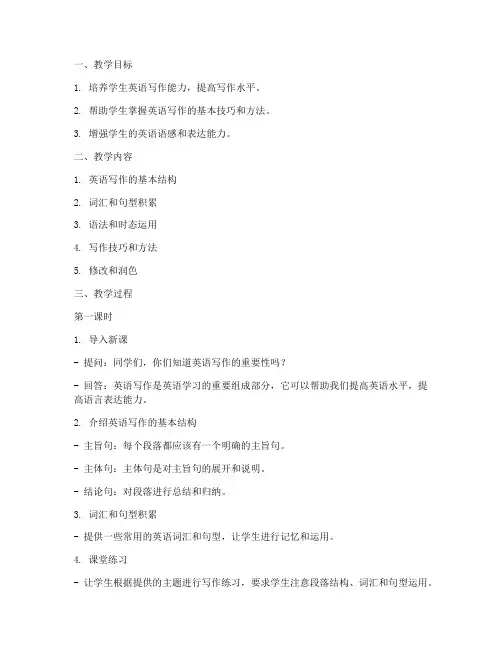
一、教学目标1. 培养学生英语写作能力,提高写作水平。
2. 帮助学生掌握英语写作的基本技巧和方法。
3. 增强学生的英语语感和表达能力。
二、教学内容1. 英语写作的基本结构2. 词汇和句型积累3. 语法和时态运用4. 写作技巧和方法5. 修改和润色三、教学过程第一课时1. 导入新课- 提问:同学们,你们知道英语写作的重要性吗?- 回答:英语写作是英语学习的重要组成部分,它可以帮助我们提高英语水平,提高语言表达能力。
2. 介绍英语写作的基本结构- 主旨句:每个段落都应该有一个明确的主旨句。
- 主体句:主体句是对主旨句的展开和说明。
- 结论句:对段落进行总结和归纳。
3. 词汇和句型积累- 提供一些常用的英语词汇和句型,让学生进行记忆和运用。
4. 课堂练习- 让学生根据提供的主题进行写作练习,要求学生注意段落结构、词汇和句型运用。
第二课时1. 复习上节课内容- 提问:同学们,上节课我们学习了哪些内容?- 回答:上节课我们学习了英语写作的基本结构、词汇和句型积累。
2. 语法和时态运用- 介绍常用的英语语法和时态,让学生进行练习。
3. 写作技巧和方法- 讲解一些写作技巧和方法,如:如何开头、如何结尾、如何过渡等。
4. 课堂练习- 让学生根据提供的主题进行写作练习,要求学生注意语法和时态运用。
第三课时1. 复习上节课内容- 提问:同学们,上节课我们学习了哪些内容?- 回答:上节课我们学习了英语写作的基本结构、词汇和句型积累、语法和时态运用。
2. 修改和润色- 讲解如何修改和润色文章,如:检查语法错误、调整句子结构、丰富词汇等。
3. 课堂练习- 让学生对自己的文章进行修改和润色,然后进行互评。
4. 总结- 对本节课的内容进行总结,强调英语写作的重要性。
四、教学评价1. 课堂表现:观察学生在课堂上的参与程度、提问和回答问题的情况。
2. 作业完成情况:检查学生的作业完成情况,评估学生的写作水平。
3. 期末考试:通过期末考试,全面评估学生的英语写作能力。
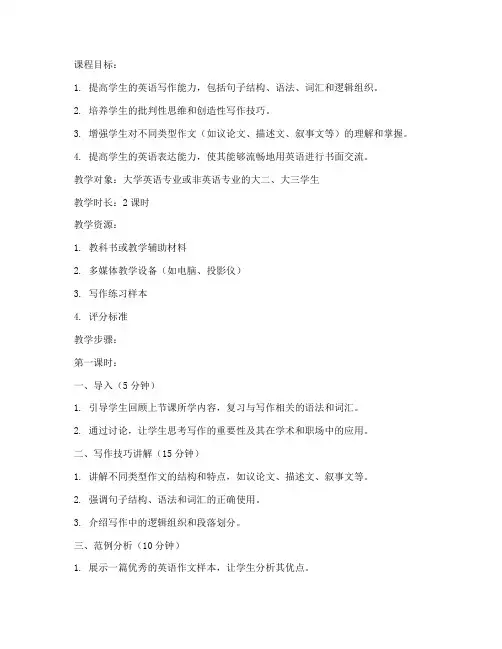
课程目标:1. 提高学生的英语写作能力,包括句子结构、语法、词汇和逻辑组织。
2. 培养学生的批判性思维和创造性写作技巧。
3. 增强学生对不同类型作文(如议论文、描述文、叙事文等)的理解和掌握。
4. 提高学生的英语表达能力,使其能够流畅地用英语进行书面交流。
教学对象:大学英语专业或非英语专业的大二、大三学生教学时长:2课时教学资源:1. 教科书或教学辅助材料2. 多媒体教学设备(如电脑、投影仪)3. 写作练习样本4. 评分标准教学步骤:第一课时:一、导入(5分钟)1. 引导学生回顾上节课所学内容,复习与写作相关的语法和词汇。
2. 通过讨论,让学生思考写作的重要性及其在学术和职场中的应用。
二、写作技巧讲解(15分钟)1. 讲解不同类型作文的结构和特点,如议论文、描述文、叙事文等。
2. 强调句子结构、语法和词汇的正确使用。
3. 介绍写作中的逻辑组织和段落划分。
三、范例分析(10分钟)1. 展示一篇优秀的英语作文样本,让学生分析其优点。
2. 引导学生讨论作文中的句子结构、语法、词汇和逻辑组织。
四、小组讨论(10分钟)1. 将学生分成小组,每组讨论一个特定的写作话题。
2. 鼓励学生运用所学技巧,尝试用英语撰写一段短文。
五、课堂练习(10分钟)1. 提供一个写作话题,要求学生在规定时间内完成一段短文。
2. 强调写作过程中的时间管理和注意力集中。
第二课时:一、课堂回顾(5分钟)1. 回顾上节课的写作练习,让学生分享自己的写作心得。
2. 提出一些常见错误,引导学生注意避免。
二、作文批改(20分钟)1. 将学生的作文分成几份,每个学生负责批改一份。
2. 引导学生按照评分标准进行批改,关注句子结构、语法、词汇和逻辑组织。
三、小组互评(10分钟)1. 各小组展示自己的作文,其他小组成员进行评价。
2. 强调互相学习和借鉴的重要性。
四、总结与反馈(5分钟)1. 教师总结本节课的重点内容,强调写作技巧的重要性。
2. 收集学生对教学的反馈意见,以便改进教学方法。
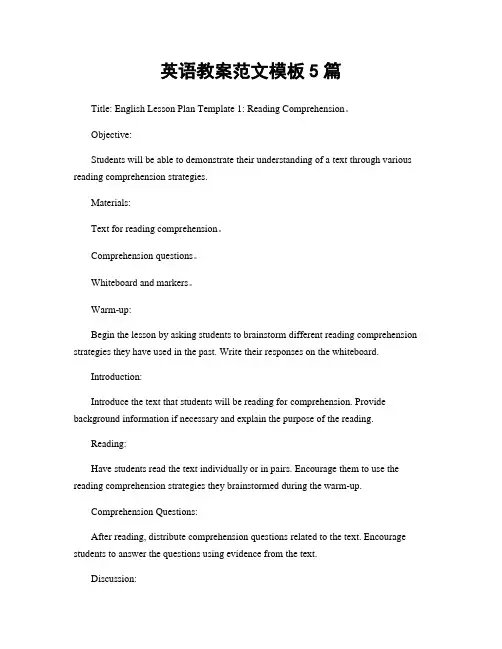
英语教案范文模板5篇Title: English Lesson Plan Template 1: Reading Comprehension。
Objective:Students will be able to demonstrate their understanding of a text through various reading comprehension strategies.Materials:Text for reading comprehension。
Comprehension questions。
Whiteboard and markers。
Warm-up:Begin the lesson by asking students to brainstorm different reading comprehension strategies they have used in the past. Write their responses on the whiteboard.Introduction:Introduce the text that students will be reading for comprehension. Provide background information if necessary and explain the purpose of the reading.Reading:Have students read the text individually or in pairs. Encourage them to use the reading comprehension strategies they brainstormed during the warm-up.Comprehension Questions:After reading, distribute comprehension questions related to the text. Encourage students to answer the questions using evidence from the text.Discussion:Lead a class discussion about the text and the comprehension questions. Encourage students to share their answers and explain their reasoning.Extension Activity:For an extension activity, have students write a short summary of the text or create a visual representation (such as a poster or a drawing) to demonstrate their understanding.Assessment:Assess students' understanding based on their responses to the comprehension questions, their participation in the discussion, and their extension activity.Closure:Conclude the lesson by reviewing the reading comprehension strategies that students used and discussing how they can apply these strategies to other texts.Title: English Lesson Plan Template 2: Vocabulary Building。
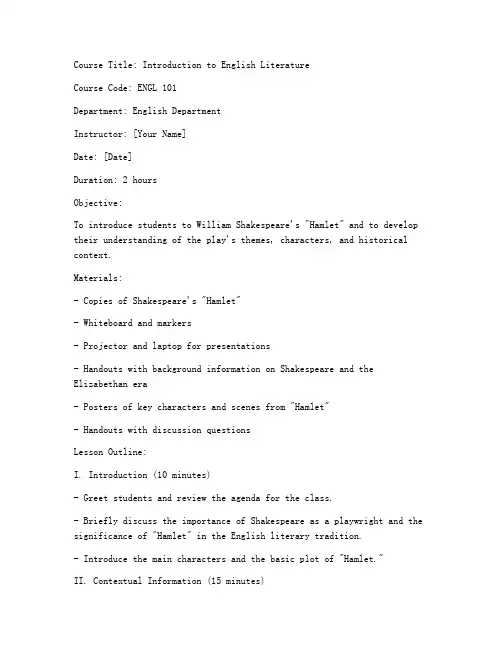
Course Title: Introduction to English LiteratureCourse Code: ENGL 101Department: English DepartmentInstructor: [Your Name]Date: [Date]Duration: 2 hoursObjective:To introduce students to William Shakespeare's "Hamlet" and to develop their understanding of the play's themes, characters, and historical context.Materials:- Copies of Shakespeare's "Hamlet"- Whiteboard and markers- Projector and laptop for presentations- Handouts with background information on Shakespeare and the Elizabethan era- Posters of key characters and scenes from "Hamlet"- Handouts with discussion questionsLesson Outline:I. Introduction (10 minutes)- Greet students and review the agenda for the class.- Briefly discuss the importance of Shakespeare as a playwright and the significance of "Hamlet" in the English literary tradition.- Introduce the main characters and the basic plot of "Hamlet."II. Contextual Information (15 minutes)- Project a PowerPoint presentation on William Shakespeare and the Elizabethan era, covering aspects such as the social, political, and cultural context of the time.- Discuss the themes of revenge, betrayal, and madness that are prevalent in "Hamlet."- Hand out background information on the historical setting and the cultural significance of the play.III. Character Analysis (20 minutes)- Divide students into small groups and assign each group a character to analyze: Hamlet, Ophelia, Claudius, Gertrude, Polonius, Laertes, and Fortinbras.- Each group will prepare a short presentation on their assigned character, focusing on their motivations, relationships with other characters, and their role in the play.- Groups will present their findings to the class, and the instructor will facilitate a discussion to delve deeper into the characters' complexities.IV. Scene Analysis (20 minutes)- Choose a key scene from "Hamlet," such as the "To be or not to be" soliloquy or the play's famous "丹麦王子复仇记" (Elsinore's Castle) scene.- Discuss the scene's significance in the overall plot and the development of the characters.- Encourage students to analyze the use of language, imagery, and symbolism in the scene.V. Group Discussion (15 minutes)- Hand out a set of discussion questions related to the themes of the play.- Divide students into groups and ask them to discuss their answers to the questions.- Groups will report back to the class, sharing their insights and opinions.VI. Conclusion (10 minutes)- Summarize the key points discussed in the class.- Assign a short writing assignment where students will write a critical essay on a selected theme from "Hamlet."- Provide information on the next class session, which will focus on further analysis of "Hamlet."Assessment:- Participation in class discussions and group activities.- Completion of the short writing assignment.- Attendance and engagement in the lesson.Homework:- Read the assigned scenes from "Hamlet" before the next class.- Prepare a one-page summary of the character analysis for the next session.Notes:- Ensure that students have access to the text of "Hamlet" for the duration of the course.- Be prepared to clarify any confusion regarding Shakespearean language and the play's complex plot.- Encourage students to think critically and to form their own interpretations of the play.。
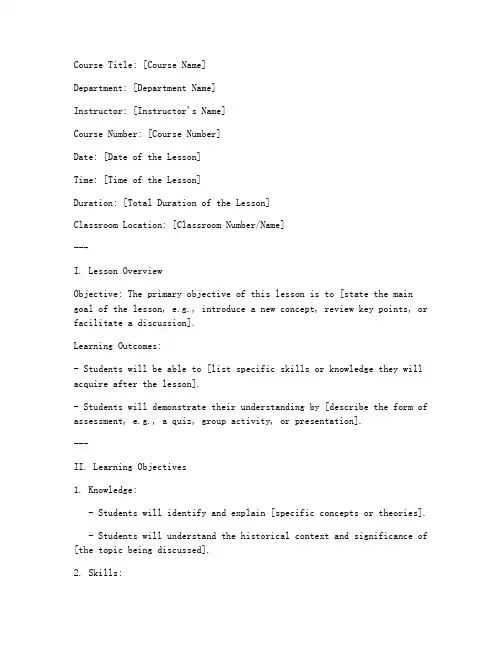
Course Title: [Course Name]Department: [Department Name]Instructor: [Instructor's Name]Course Number: [Course Number]Date: [Date of the Lesson]Time: [Time of the Lesson]Duration: [Total Duration of the Lesson]Classroom Location: [Classroom Number/Name]---I. Lesson OverviewObjective: The primary objective of this lesson is to [state the main goal of the lesson, e.g., introduce a new concept, review key points, or facilitate a discussion].Learning Outcomes:- Students will be able to [list specific skills or knowledge they will acquire after the lesson].- Students will demonstrate their understanding by [describe the form of assessment, e.g., a quiz, group activity, or presentation].---II. Learning Objectives1. Knowledge:- Students will identify and explain [specific concepts or theories].- Students will understand the historical context and significance of [the topic being discussed].2. Skills:- Students will be able to [list specific skills, such as critical thinking, problem-solving, or research skills].- Students will practice [specific skills through activities or exercises].3. Attitudes and Values:- Students will develop an appreciation for [the topic or field of study].- Students will recognize the importance of [specific values or ethical considerations].---III. Materials- Textbook and reading materials- Handouts or worksheets- Multimedia resources (videos, podcasts, etc.)- Projector or interactive whiteboard- Writing materials (pens, paper, whiteboard markers)---IV. Lesson ProcedureA. Introduction (5 minutes)- Begin with a brief recap of the previous lesson.- Introduce the topic of the lesson and its relevance to the course.- Set clear learning objectives and expectations for the class.B. Lecture and Presentation (15-20 minutes)- Present key concepts and theories.- Use multimedia resources to enhance understanding.- Encourage students to ask questions and engage with the material.C. Interactive Activity (10-15 minutes)- Facilitate a group discussion or activity that reinforces the lesson’s objectives.- Assign roles or tasks to students to encourage active participation.- Monitor student progress and offer guidance as needed.D. Case Study or Example Analysis (10-15 minutes)- Present a real-world example or case study related to the topic.- Guide students through the analysis of the case.- Discuss the implications and applications of the case to the broader subject area.E. Review and Summarize (5 minutes)- Recap the main points of the lesson.- Highlight key takeaways and encourage students to reflect on their learning.F. Assignment and Next Steps (5 minutes)- Assign homework or additional reading.- Outline the agenda for the next class session.- Provide contact information for further assistance or clarification.---V. Assessment- Formative Assessment:- Participation in class discussions and activities.- Completion of in-class exercises and worksheets.- Peer feedback and reflection.- Summative Assessment:- Quizzes or exams covering the material presented in the lesson.- Assignments or projects that demonstrate students’ ability to apply the concepts learned.---VI. Follow-Up and Reflection- After the lesson, reflect on the effectiveness of the teaching methods and materials used.- Consider how the lesson objectives were met and identify areas for improvement.- Plan for adjustments to the lesson content or delivery in future sessions.---Note: This template is a guideline and should be customized to fit the specific needs and requirements of the course and instructor.。
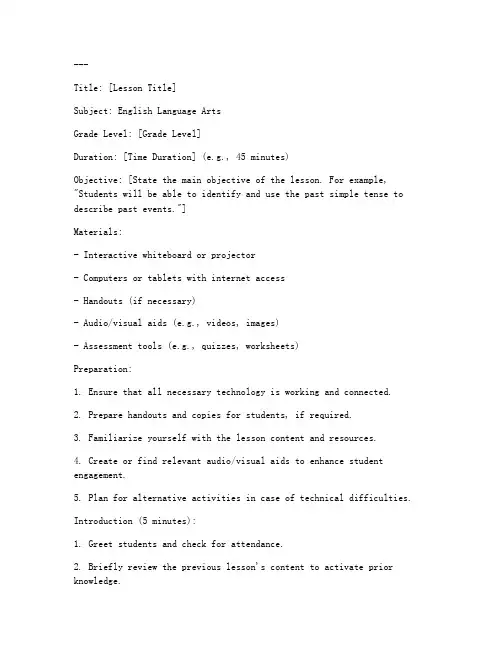
---Title: [Lesson Title]Subject: English Language ArtsGrade Level: [Grade Level]Duration: [Time Duration] (e.g., 45 minutes)Objective: [State the main objective of the lesson. For example, "Students will be able to identify and use the past simple tense to describe past events."]Materials:- Interactive whiteboard or projector- Computers or tablets with internet access- Handouts (if necessary)- Audio/visual aids (e.g., videos, images)- Assessment tools (e.g., quizzes, worksheets)Preparation:1. Ensure that all necessary technology is working and connected.2. Prepare handouts and copies for students, if required.3. Familiarize yourself with the lesson content and resources.4. Create or find relevant audio/visual aids to enhance student engagement.5. Plan for alternative activities in case of technical difficulties.Introduction (5 minutes):1. Greet students and check for attendance.2. Briefly review the previous lesson's content to activate prior knowledge.3. Introduce the main objective of the lesson clearly and concisely.Activity 1: Warm-Up (10 minutes):1. Start with a brief discussion or activity to engage students and review key vocabulary or grammar points from the previous lesson.2. Example: A quick quiz or a short group activity related to the past simple tense.Activity 2: Main Content (20 minutes):1. Present new material through various methods (e.g., lecture, discussion, demonstration).- Use interactive whiteboard or projector to display key points.- Provide examples and explanations of the target language or concept.- Engage students in activities that encourage active learning, such as pair work or group discussions.2. Break down the main content into smaller, manageable segments.- Example: Introduce the past simple tense step by step, starting with simple sentences and gradually progressing to more complex ones.3. Incorporate interactive elements to keep students engaged.- Example: Use online games or quizzes to reinforce learning.Activity 3: Practice (15 minutes):1. Provide students with opportunities to practice the new material.- Example: Have students complete a worksheet or interactive exercise on the past simple tense.2. Encourage students to work independently or in small groups.- Example: Pair students up to practice creating sentences using the past simple tense.3. Circulate around the classroom to provide individual support and monitor progress.Activity 4: Assessment (5 minutes):1. Conduct a quick formative assessment to gauge understanding.- Example: A brief quiz or a class discussion question.2. Provide immediate feedback to students to reinforce learning.Conclusion (5 minutes):1. Summarize the main points of the lesson.2. Review any key vocabulary or grammar points.3. Assign homework or additional practice activities to reinforce learning.Homework:- [Assign relevant homework tasks, such as completing a worksheet, writing a short paragraph using the past simple tense, or watching a video related to the lesson topic.]Assessment:- [Outline how student performance will be assessed, including any quizzes, tests, or projects.]Reflection:- [Include a section for the teacher to reflect on the effectiveness of the lesson, noting any areas of improvement or unexpected challenges.]---This template provides a structured framework for creating an electronic English lesson plan. Adjustments can be made based on the specific needs of the students and the resources available.。
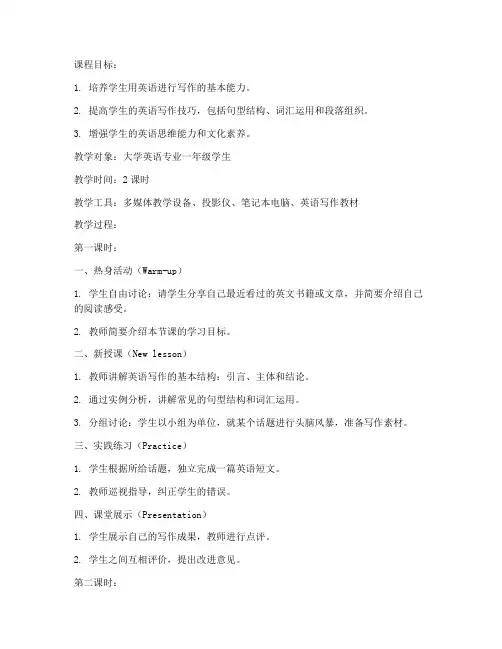
课程目标:1. 培养学生用英语进行写作的基本能力。
2. 提高学生的英语写作技巧,包括句型结构、词汇运用和段落组织。
3. 增强学生的英语思维能力和文化素养。
教学对象:大学英语专业一年级学生教学时间:2课时教学工具:多媒体教学设备、投影仪、笔记本电脑、英语写作教材教学过程:第一课时:一、热身活动(Warm-up)1. 学生自由讨论:请学生分享自己最近看过的英文书籍或文章,并简要介绍自己的阅读感受。
2. 教师简要介绍本节课的学习目标。
二、新授课(New lesson)1. 教师讲解英语写作的基本结构:引言、主体和结论。
2. 通过实例分析,讲解常见的句型结构和词汇运用。
3. 分组讨论:学生以小组为单位,就某个话题进行头脑风暴,准备写作素材。
三、实践练习(Practice)1. 学生根据所给话题,独立完成一篇英语短文。
2. 教师巡视指导,纠正学生的错误。
四、课堂展示(Presentation)1. 学生展示自己的写作成果,教师进行点评。
2. 学生之间互相评价,提出改进意见。
第二课时:一、复习上节课内容(Review)1. 教师简要回顾上节课的学习内容。
2. 学生分享自己在写作过程中遇到的问题及解决方法。
二、巩固练习(Consolidation)1. 教师提供一篇英语短文,要求学生根据文章内容进行改写或续写。
2. 学生独立完成改写或续写任务。
三、课堂展示(Presentation)1. 学生展示自己的改写或续写成果,教师进行点评。
2. 学生之间互相评价,提出改进意见。
四、总结与反馈(Summary and feedback)1. 教师对本节课的学习情况进行总结。
2. 学生分享自己在学习过程中的收获与不足。
3. 教师针对学生的反馈,提出改进建议。
教学反思:本节课通过讲解英语写作的基本结构和技巧,帮助学生掌握了英语写作的基本方法。
在实践练习环节,学生能够运用所学知识进行写作,并在课堂展示中展示自己的成果。
但在课堂展示环节,部分学生表达不够流畅,需要进一步提高口语表达能力。
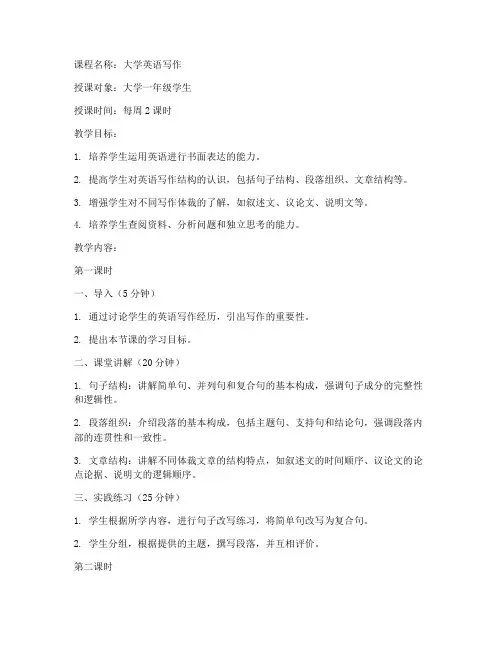
课程名称:大学英语写作授课对象:大学一年级学生授课时间:每周2课时教学目标:1. 培养学生运用英语进行书面表达的能力。
2. 提高学生对英语写作结构的认识,包括句子结构、段落组织、文章结构等。
3. 增强学生对不同写作体裁的了解,如叙述文、议论文、说明文等。
4. 培养学生查阅资料、分析问题和独立思考的能力。
教学内容:第一课时一、导入(5分钟)1. 通过讨论学生的英语写作经历,引出写作的重要性。
2. 提出本节课的学习目标。
二、课堂讲解(20分钟)1. 句子结构:讲解简单句、并列句和复合句的基本构成,强调句子成分的完整性和逻辑性。
2. 段落组织:介绍段落的基本构成,包括主题句、支持句和结论句,强调段落内部的连贯性和一致性。
3. 文章结构:讲解不同体裁文章的结构特点,如叙述文的时间顺序、议论文的论点论据、说明文的逻辑顺序。
三、实践练习(25分钟)1. 学生根据所学内容,进行句子改写练习,将简单句改写为复合句。
2. 学生分组,根据提供的主题,撰写段落,并互相评价。
第二课时一、复习上节课内容(5分钟)1. 回顾上节课所学的句子结构、段落组织和文章结构。
2. 学生分享上节课的实践练习心得。
二、课堂讲解(20分钟)1. 不同体裁的写作技巧:详细介绍叙述文、议论文和说明文的写作技巧。
2. 写作中的过渡与衔接:讲解如何使用过渡词和短语,使文章更加流畅。
三、实践练习(25分钟)1. 学生根据所学内容,选择一种体裁,撰写短文。
2. 教师选取优秀作品进行展示,并给予点评。
四、总结与布置作业(10分钟)1. 总结本节课的学习内容。
2. 布置课后作业:学生根据所学内容,完成一篇完整的英语短文。
教学方法:1. 讲授法:讲解写作基础知识。
2. 练习法:通过实践练习,巩固所学知识。
3. 讨论法:鼓励学生积极参与课堂讨论,提高写作能力。
教学评价:1. 课堂表现:观察学生在课堂上的参与度和积极性。
2. 作业完成情况:检查学生课后作业的质量。
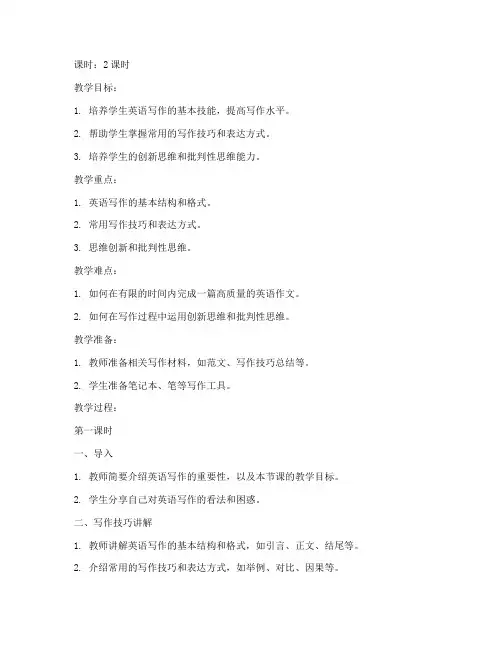
课时:2课时教学目标:1. 培养学生英语写作的基本技能,提高写作水平。
2. 帮助学生掌握常用的写作技巧和表达方式。
3. 培养学生的创新思维和批判性思维能力。
教学重点:1. 英语写作的基本结构和格式。
2. 常用写作技巧和表达方式。
3. 思维创新和批判性思维。
教学难点:1. 如何在有限的时间内完成一篇高质量的英语作文。
2. 如何在写作过程中运用创新思维和批判性思维。
教学准备:1. 教师准备相关写作材料,如范文、写作技巧总结等。
2. 学生准备笔记本、笔等写作工具。
教学过程:第一课时一、导入1. 教师简要介绍英语写作的重要性,以及本节课的教学目标。
2. 学生分享自己对英语写作的看法和困惑。
二、写作技巧讲解1. 教师讲解英语写作的基本结构和格式,如引言、正文、结尾等。
2. 介绍常用的写作技巧和表达方式,如举例、对比、因果等。
三、范文分析1. 教师展示一篇优秀的英语作文,引导学生分析其优点和写作技巧。
2. 学生分组讨论,总结范文中的写作技巧和表达方式。
四、写作练习1. 学生根据所学技巧,尝试完成一篇短文。
2. 教师巡视指导,纠正学生写作中的错误。
五、课堂小结1. 教师总结本节课所学内容,强调写作技巧和表达方式的重要性。
2. 学生分享自己的写作心得和体会。
第二课时一、复习1. 教师提问,检查学生对上节课所学内容的掌握程度。
2. 学生回答问题,巩固所学知识。
二、写作指导1. 教师针对学生上节课的写作练习,点评并提出改进建议。
2. 学生根据教师建议,修改自己的作文。
三、创新思维和批判性思维训练1. 教师讲解创新思维和批判性思维在写作中的重要性。
2. 学生进行小组讨论,提出自己的观点,并进行辩论。
四、写作实践1. 学生根据所学技巧和创新思维,完成一篇英语作文。
2. 教师巡视指导,纠正学生写作中的错误。
五、课堂小结1. 教师总结本节课所学内容,强调创新思维和批判性思维在写作中的重要性。
2. 学生分享自己的写作心得和体会。
Introduction:A well-structured and detailed lesson plan is essential for effective teaching and learning. This essay aims to provide a template for an excellent lesson plan that can be used in universities. The template includes various sections to ensure comprehensive coverage of the lesson objectives, content, teaching methods, and assessment strategies.I. Introduction1. Course Title: Specify the name of the course for which the lesson plan is designed.2. Course Number: Provide the course number for easy reference.3. Date and Time: Mention the date and time of the lesson.4. Duration: Specify the duration of the lesson (e.g., 50 minutes, 1 hour).5. Learning Objectives: Outline the main goals and objectives of the lesson, emphasizing what students should be able to achieve by the end of the lesson.II. Lesson Content1. Topic: Clearly state the topic or subject matter to be covered in the lesson.2. Subtopics: Break down the main topic into smaller, manageable subtopics or sections.3. Key Concepts: Identify the key concepts and ideas that students need to understand.4. Learning Resources: List any resources needed for the lesson, such as textbooks, articles, multimedia materials, or online resources.III. Teaching Methods1. Lecture: Describe the planned lecture format, including the main points to be covered and any interactive elements (e.g., questions, discussions).2. Group Work: If applicable, specify the group work activities, roles, and time allocation.3. Case Studies/Activities: Outline any case studies, hands-onactivities, or practical exercises to be conducted during the lesson.4. Demonstrations: Mention any demonstrations or experiments to be performed, along with safety precautions and time required.5. Guest Speakers: If a guest speaker is involved, provide details about their background and the topic they will cover.IV. Assessment1. Formative Assessment: Describe any formative assessments to be used during the lesson, such as quizzes, class discussions, or group presentations.2. Summative Assessment: Outline the summative assessment for the lesson, such as an assignment, test, or project.3. Assessment Criteria: Specify the criteria for evaluating student performance and achievements.4. Feedback: Explain how feedback will be provided to students,including the timing and format.V. Materials and Resources1. Handouts: List any handouts or handouts that will be distributed during the lesson.2. Visual Aids: Mention any visual aids, such as slides, posters, or charts, to be used.3. Technology: Describe any technology or software needed for the lesson, such as a computer, projector, or presentation software.VI. Reflection1. Lesson Evaluation: Reflect on the effectiveness of the lesson, noting any successes or areas for improvement.2. Student Feedback: Collect and analyze student feedback to gaininsights into their learning experience.3. Follow-Up: Outline any follow-up activities or lessons that will be conducted based on the outcomes of the current lesson.Conclusion:An excellent lesson plan template, as outlined in this essay, can help university instructors design and deliver effective and engaging lessons. By following this template, instructors can ensure that their lessonsare well-structured, cover the necessary content, and provide opportunities for students to achieve the desired learning outcomes.。
Subject: English for University StudentsCourse: First Year English CompositionDuration: 2 hoursLearning Objectives:1. Students will be able to understand the basic structure and purpose of academic writing.2. Students will learn how to write an effective introduction, body paragraphs, and conclusion.3. Students will improve their vocabulary and grammar skills relevant to academic writing.4. Students will develop critical thinking and analytical skills through the analysis of sample academic texts.Materials:1. Projector and computer for presentations.2. Handouts with sample academic texts and writing prompts.3. Writing materials (pens, paper, etc.).4. Grammar and vocabulary worksheets.Teaching Methodology:1. Interactive Presentation: Use a PowerPoint presentation to introduce the key concepts of academic writing.2. Group Work: Assign students to work in small groups to analyze sample texts and discuss their structure and purpose.3. Guided Practice: Provide step-by-step guidance on writing an academic essay.4. Peer Review: Encourage students to review each other’s work and provide constructive feedback.Lesson Outline:I. Introduction (10 minutes)- Greet students and briefly review the previous lesson.- Introduce the topic: "Introduction to Academic Writing."- Explain the importance of academic writing in university education.II. Presentation: The Structure of Academic Writing (20 minutes)- Use a PowerPoint presentation to explain the basic structure of academic writing.- Discuss the following components:- Introduction: The purpose of the introduction, including the thesis statement.- Body Paragraphs: The structure of a body paragraph, including topic sentences, supporting details, and transitions.- Conclusion: The purpose of the conclusion, including summarizing the main points and restating the thesis statement.- Provide examples from sample academic texts to illustrate each component.III. Group Work: Analyzing Sample Texts (30 minutes)- Divide students into small groups.- Provide each group with a sample academic text.- Instruct students to analyze the structure and purpose of the text.- Have each group present their findings to the class.IV. Guided Practice: Writing an Academic Essay (20 minutes)- Provide a writing prompt related to the topic of the course.- Explain the step-by-step process of writing an academic essay.- Demonstrate how to write an effective introduction, body paragraphs, and conclusion using the writing prompt.- Encourage students to follow along and practice writing their own essays.V. Peer Review (20 minutes)- Pair students up and distribute copies of their essays.- Instruct students to review each other’s essays and provide constructive feedback.- Encourage students to focus on the structure, grammar, and vocabulary of the essays.VI. Conclusion (10 minutes)- Summarize the key points discussed in the lesson.- Answer any questions students may have.- Assign homework: Students are to write a short academic essay based on the writing prompt provided during the lesson.Assessment:- Active participation in class discussions and group work.- Quality of the essay written during the lesson.- Feedback from peers during the peer review session.Homework:- Write a 300-500-word academic essay on the topic provided during the lesson. The essay should include an introduction, three body paragraphs, and a conclusion.Note: This teaching plan is designed to be adaptable to the specific needs and abilities of the students. Adjustments may be made as necessary to ensure an effective learning experience.。
I. IntroductionA. Course Name: College English WritingB. Course Duration: 2 hoursC. Teaching Objectives:1. To help students understand the structure and format of a college English essay.2. To teach students how to develop a topic and organize their thoughts effectively.3. To improve students' writing skills and ability to express their ideas clearly and coherently.II. Teaching ContentA. Introduction to the essay format1. Definition and purpose of an essay2. Types of essays: expository, persuasive, narrative, and argumentative3. Basic structure of an essay: introduction, body paragraphs, and conclusionB. Developing a topic and thesis statement1. How to choose a suitable topic2. The importance of a thesis statement3. Writing a clear and concise thesis statementC. Organizing thoughts and writing body paragraphs1. Developing main ideas and supporting details2. Using transitional words and phrases3. Writing effective topic sentences and concluding sentencesD. Writing the introduction1. Catching the reader's attention2. Providing background information3. Introducing the thesis statementE. Writing the conclusion1. Summarizing the main points2. Restating the thesis statement3. Providing a final thought or call to actionIII. Teaching MethodsA. Lectures: To explain the structure and format of an essay.B. Demonstrations: To show students how to write a well-organized essay.C. Group activities: To encourage students to work together and share their ideas.D. Peer review: To help students improve their writing skills by providing feedback on each other's essays.IV. Teaching ProceduresA. Introduction (10 minutes)1. Briefly introduce the essay format and its importance.2. Discuss the types of essays and their purposes.B. Developing a topic and thesis statement (15 minutes)1. Discuss how to choose a suitable topic.2. Explain the importance of a thesis statement.3. Demonstrate how to write a clear and concise thesis statement.C. Organizing thoughts and writing body paragraphs (20 minutes)1. Discuss the process of developing main ideas and supporting details.2. Introduce transitional words and phrases.3. Demonstrate how to write effective topic sentences and concluding sentences.D. Writing the introduction (15 minutes)1. Explain how to catch the reader's attention.2. Discuss the importance of providing background information.3. Demonstrate how to introduce the thesis statement.E. Writing the conclusion (10 minutes)1. Discuss the importance of summarizing the main points.2. Explain how to restate the thesis statement.3. Provide examples of final thoughts or calls to action.F. Group activities and peer review (15 minutes)1. Divide students into groups and assign them a topic to write about.2. Encourage students to work together and share their ideas.3. Have students exchange their essays and provide feedback.G. Conclusion (5 minutes)1. Summarize the key points covered in the lesson.2. Encourage students to practice writing essays on their own.V. AssessmentA. Participation: Students' active participation in class discussions and group activities.B. Peer review: The quality of feedback provided by students during the peer review session.C. Essay writing: The ability of students to write a well-organized and coherent essay based on the lesson content.。
Subject: English CompositionCourse Level: University LevelDuration: One Semester (16 weeks)Course Description:This course is designed to enhance the writing skills of university students. It focuses on developing advanced writing techniques,including argumentative writing, analytical writing, and creative writing. Students will learn to write effectively for different academic purposes, such as research papers, critical reviews, and personal narratives.Objectives:1. To improve students' overall writing skills, including grammar, vocabulary, and style.2. To develop critical thinking and analytical skills through expository and argumentative writing.3. To encourage creativity and originality in creative writing assignments.4. To familiarize students with various academic writing genres and formats.5. To enhance students' ability to conduct research and use evidence effectively in their writing.Teaching Methods:- Lectures: To introduce key concepts and provide a framework for writing.- Workshops: To practice writing skills in a supportive group setting.- Peer Review: To provide feedback and improve writing through collaboration.- Individual Consultations: To offer personalized feedback and guidance.- Online Resources: To utilize online tools and platforms for research and writing.Week-by-Week Schedule:Week 1-2: Introduction to Academic Writing- Overview of the course and expectations.- Introduction to academic writing genres and formats.- Grammar review: sentence structure and sentence variety.Week 3-4: Argumentative Writing- Understanding the structure of argumentative essays.- Developing a thesis statement and supporting arguments.- Critically analyzing sources and using evidence effectively.Week 5-6: Analytical Writing- Analyzing texts and identifying key themes and arguments.- Writing critical reviews and research papers.- Developing a logical argument and presenting evidence effectively. Week 7-8: Creative Writing- Exploring the elements of creative writing, including character development, setting, and plot.- Writing short stories, poetry, or creative non-fiction.- Peer review and feedback sessions.Week 9-10: Research Writing- Introduction to research methods and sources.- Writing a research proposal and conducting research.- Writing the introduction and methodology sections of a research paper.Week 11-12: Editing and Proofreading- Techniques for editing and proofreading one's own work.- Peer editing and feedback sessions.- Introduction to style guides and academic conventions.Week 13-14: Final Projects- Students begin working on their final projects, which may include a research paper, a creative writing piece, or an extended argumentative essay.- Regular consultations with the instructor to provide guidance and support.Week 15-16: Final Presentations and Assessments- Students present their final projects to the class.- Students submit their final written assignments.- Course evaluations and wrap-up.Assessment:- Class Participation: 20%- Writing Assignments: 40%- Argumentative Essay: 10%- Analytical Essay: 10%- Creative Writing: 10%- Research Paper: 10%- Final Project: 30%- Research Paper/Extended Essay: 20%- Creative Writing Piece: 10%Materials:- Textbooks on academic writing and argumentation.- Access to academic databases for research.- Writing software and online grammar tools.- Course syllabus and handouts.Evaluation Criteria:- Clarity and coherence of the writing.- Correctness of grammar and mechanics.- Use of appropriate vocabulary and style.- Ability to analyze and synthesize information.- Originality and creativity in creative writing.Conclusion:This advanced English writing course aims to equip university students with the skills necessary to excel in their academic and professional pursuits. Through a combination of lectures, workshops, and individual consultations, students will develop a strong foundation in various writing genres and techniques.。
课程目标:1. 帮助学生提高英语写作能力,包括语法、词汇、结构和逻辑思维。
2. 培养学生撰写不同类型文章的能力,如议论文、说明文、记叙文等。
3. 增强学生的批判性思维和创造性写作技巧。
教学对象:大学英语一年级学生教学时间:2课时教学准备:1. 多媒体课件2. 课堂练习材料3. 评分标准教学过程:第一课时一、导入(5分钟)1. 用英语简短介绍本次课的主题和目标。
2. 通过提问引导学生思考英语写作的重要性。
二、讲解写作技巧(15分钟)1. 分析英语写作的基本要素:语法、词汇、结构和逻辑。
2. 讲解不同类型文章的写作结构,如议论文、说明文、记叙文等。
3. 强调批判性思维在写作中的作用。
三、示例分析(10分钟)1. 展示一篇优秀的英语作文,分析其优点和特点。
2. 引导学生讨论并总结优秀作文的写作技巧。
四、课堂练习(15分钟)1. 分组讨论,让学生根据所学技巧撰写短文。
2. 教师巡视指导,解答学生疑问。
五、总结与反馈(5分钟)1. 总结本次课的重点内容。
2. 鼓励学生在课后继续练习,提高写作能力。
第二课时一、复习与巩固(10分钟)1. 回顾上节课所学内容,检查学生对写作技巧的掌握程度。
2. 通过提问和小组讨论,巩固所学知识。
二、写作练习(20分钟)1. 学生独立完成一篇英语作文,题目自拟。
2. 教师巡视指导,关注学生写作过程中的问题。
三、互评与反馈(15分钟)1. 学生之间互相批改作文,给出意见和建议。
2. 教师选取几篇作文进行点评,指出优点和不足。
四、总结与拓展(5分钟)1. 总结本次课的重点内容,强调写作练习的重要性。
2. 鼓励学生在课后继续练习,提高写作能力。
教学评价:1. 学生课堂参与度:观察学生在课堂练习和讨论中的表现。
2. 学生作文质量:通过批改学生作文,了解学生的写作水平。
3. 学生反馈:收集学生对本次课的评价和建议,为今后的教学提供参考。
教学反思:1. 分析学生在写作过程中遇到的问题,调整教学方法。
教学目标:1. 培养学生英语写作的基本能力,包括语法、词汇、句型等方面。
2. 提高学生英语写作的兴趣和自信心。
3. 培养学生分析问题和解决问题的能力。
4. 培养学生良好的写作习惯。
教学重点:1. 英语写作的基本技巧和规范。
2. 英语写作的构思和布局。
3. 英语写作的语法、词汇和句型运用。
教学难点:1. 英语写作的构思和布局。
2. 英语写作的语法、词汇和句型运用。
教学过程:一、导入1. 复习上一节课的内容,让学生回顾英语写作的基本技巧和规范。
2. 引导学生思考:如何提高英语写作能力?二、新课讲解1. 英语写作的基本技巧和规范a. 介绍英语写作的基本结构:引言、正文、结论。
b. 讲解英语写作的语法、词汇和句型运用。
c. 强调写作过程中的逻辑性和连贯性。
2. 英语写作的构思和布局a. 引导学生思考如何确定写作主题。
b. 讲解如何进行头脑风暴,寻找写作素材。
c. 介绍写作过程中的段落划分和过渡技巧。
三、课堂练习1. 学生根据所学知识,自选主题进行写作练习。
2. 教师巡视指导,纠正学生的错误,并给予鼓励和建议。
四、课堂展示1. 邀请部分学生展示自己的写作成果。
2. 全班同学对展示作品进行评价,提出修改意见。
五、总结1. 回顾本节课所学内容,强调英语写作的基本技巧和规范。
2. 布置课后作业,要求学生完成一篇英语作文。
教学反思:1. 本节课是否达到了预期的教学目标?2. 学生在课堂上的参与度如何?3. 教学过程中是否遇到了难点,如何解决?4. 课后作业的设计是否合理,能否提高学生的写作能力?教学资源:1. 教材2. 教学课件3. 英语写作练习册4. 互联网资源教学评价:1. 学生对英语写作的兴趣和自信心是否提高?2. 学生英语写作的基本技巧和规范是否掌握?3. 学生在课后作业中的表现是否有所提高?。
1. My view on…(就...问题,我的观点)Model 1 模板一Para 1第一段Different people have different views on... It is held/ believed/ thought/ recognized/ acknowledged that...But it is also held that ...就...而言,不同的人有不同的观点(见仁见智)。
大家都认为...但也有人认为...Those who hold the first opinion feel…In contrast/however/on the contrary, those who hold the second viewbelieve/suggest/argue/believe/think that…持第一个观点的人认为...相反地,持第二个观点的人认为Para 2 第二段As to me,I agree with the former/latter opinion.… 我赞同前者/后者Inmy I am for From my standpoint / viewpoint, Iam in favor ofFrom my point of view, I am supportive ofAs far as I am concernedWhat’s more,…Moreover ,…Furthermore,…Besides,…Para 3 结尾段In a word, …In sumIn briefIn short It’s necessaryto take a correct attitude to…. Only …, can we …In conclusion 对...持正确的态度是有必要的。
只有...,我们才能...To sum upAs is mentioned above,Taking all the above into consideration,Model 2 模板二Para 1第一段With the arrival / birth / …, sth is becoming more and more … in our life / society.随着...到来/诞生,在我们生活/社会中...变得越来越...When asked about ..., different people will offer different opinions.当问及...时,不同的人有不同的观点,Some people take it for granted that…However, others hold that…一些人认为...是理所当然的,然而,另一人则认为...As far as I’m concerned, I am in favor of the second view. The reasonsare as follows.在我看来,我赞同第二种观点。
原因如下Para 2 第二段Firstly For example/For instancTo begin with, Here are afew examples to illustrate…For one thing, On one hand,In the first place,Second,For one thing,... For another....Next/ Besides/ In addition on one hand,....on the other hand...只可For another, 用于例举两个理由(即首先,最后)On the other hand,In the second place,LastLastly, finallyLast but not the least/ Worst ofallPara 3 结尾段In conclusion,…其2. Advantages and Disadvantages of …(评论优缺点)Para 1第一段Nowadays, …be very popular around us. Like every thing else, …have both favorable and unfavorable aspects.如今,....变得十分流行/受欢迎。
像其他的事物一样,...有利也有弊。
Para 2 第二段Generally, the positive aspects can be listed as follows.一般来说,其积极面如下。
First, people base their opinion on the grounds that …besides, as they often point out, … is most important of all. As the saying goes: …首先,人们的观点建立在...之上。
除此,正如他们指出的一样,...是最重要的,正如...谚语所说。
But every coin has two sides. The negative aspects are also apparent/clear.但任何事物都有两面性。
其消极面也很明显。
First... Second....third....Para 3 结尾段As far as I am concerned, whether it does good or harm to human society depends on how we …Therefore,…在我看来,它对社会的利弊取决于我们怎样....因此....3.How to …(方式方法)Para 1第一段Much to our delight / distress, the past decades / these years have seen / witnessed the … of sth. If this current is allowed to take its course, things are bound to turn for better / worse. Therefore, people are showing growing concern on how to …令我们高兴/难过的是,在过去几十年间/这些年间,我们看到了...如果按现在的情况发展下去,事情可能会变得更好/更坏。
因此,人们越来越关注怎样处理...问题Para 2 第二段Many ways can contribute to solving this serious problem. But the following ones may be most effective.First of all,…besides,…finally,… / In my opinion, the first step should be focused on …; Then greater efforts should be made to …,有很多方法都能解决这个棘手的问题。
但是一下几点最有效。
首先...其次...最后.../在我看来,首先应该将重心放在...上;其次,更应在....方面更加努力。
Para 3 结尾段These are not the best and the only three measures we can take. But it should be noted that we should take strong actions to … In general, where there is a will, there is a way.这并不是我们能采取做好的或仅有的三种措施。
但请注意,我们应该针对...采取更强有力的措施。
总之,有志者事竟成。
4. A or B…(选择类)Para 1第一段Whenever we … it is inevitable for us tomeet the choice between…come across the problem of whether we should …or.每当我们...,面对...的选择是不可避免的And it is natural for different opinions to arise.不同的人有不同的观点Para 2 第二段Some people think we should ….give priority to …They say that …. Furthermore … Therefore, we should…But other people think otherwise. They argue that we should not only… but also…但有的人持相反观点...In my opinion, we should … To begin with…Besides…在我看来,我们应该...Para 3 结尾段Only in this way, can we…只有这样,我们才能...5. Why…(原因类作文)Para 1第一段With the rapid development of ...in our society, ...has been discussed a lot. According to…, people, especially college students/..., are showing more and more interest in …To get a better sense of it, it is necessary for us to find out its causes / reasons.随着社会...的飞速发展,...已成为人们热议的话题。
根据...,人们,尤其是学生,越来越关注...为了更好的了解它,找出它的原因是极有必要的。
Para 2 第二段The reasons, in my mind, can be summed up in three aspects:在我看来,原因总结为一下三方面:Three main factors /reasons are well worth our concern/should call for more of our concern.三个原因值得我们注意Three main factors in my mind, can account for…contribute to…leadto…result in…bere sponsible for…我认为,有三个原因会导致...In the first place, it is theproduct of…, In the second place, it is seen as an ideal way of… Finally, …首先,它是...的产物;其次,它被视为是解决...的理想方法;最后...Para 3 结尾段With more and more…added / attached to the trend, I am fully convinced / I am deeply worried, it will certainly become...in the future.随着...潮流的加剧,我深信/我担心,将来它会变得越来越...6. 图表作文(在上述类型前加上图表分析即可)As can be seen from the graph /table / diagram, there have been dramatic changes in the past period from __ to __. To be concre te …only… in __(year) while / whereas the ratio(s) went up to…. These changes are most disturbing, so it is necessary for us to go into the whys and wherefores of them first.从图表中可看出,在过去(几年间)发生了巨大的变化。